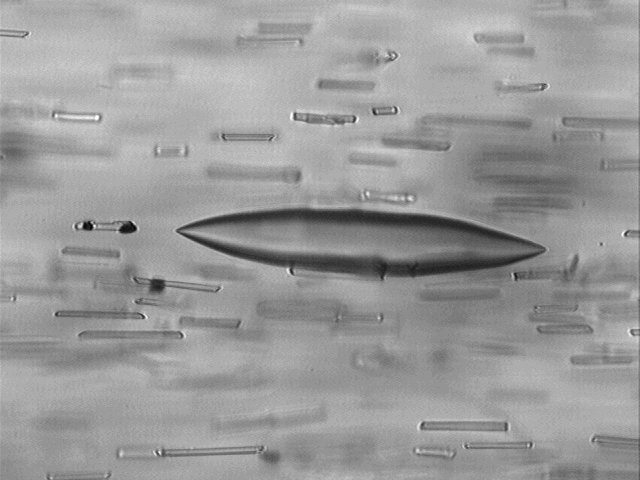
Stretched bubble (about 100 microns long) in obsidian;
from its shape we can infer both the flow type and strain rate,
and perhaps more interesting, we can determine the visous
stresses in the flow
(from work with graduate student Alison Rust)
The goal of this lab is to identify structures in banded obsidian, to
understand their origin, and to figure what we can learn from these structures.
In particular, what can we learn from microlites and bubbles (see image below)?

Stretched bubble (about 100 microns long) in obsidian;
from its shape we can infer both the flow type and strain rate,
and perhaps more interesting, we can determine the visous
stresses in the flow
(from work with graduate student Alison Rust)
All 14 thin sections are from Obsidian Dome in Eastern CA. Obsidian dome was extruded about 550 years ago. Its emplacement was preceded by a series of sub-Plinian eruptions (see Miller, Geology, 13: 14-17 (1985) for more details). The eastern CA obsidian flows are well preserved because of the arid climate.
Obsidian flows, such as Obsidian Dome, are common in the Western US and represent a large fractional of Holocene eruptions. No geologists, however, has witnessed their eruption so information about how they form and how rapidly they erupt is based on features preserved in the flow. One distinctive feature of obsidian is its low water content (about 0.2%) so water (bubbles near the surface) must have been lost. The mechanism for forming obsidian flows, remains controversial. Did they erupt as foams and then lose bubbles through coalescence and the escape of gas (Eichelberger et al., Nature, 323, 589-602 (1986))? or did the magma lose gas during ascent?
For this lab a preprint by Jon Castro at Oberlin College will useful for interpreting the microlites (I will provide it in class) and a preprint of a paper by Alison Rust at Oregon will help with interpreting any bubbles you find.
This lab will take two weeks.
Questions

Last modified 26 January 2002
Return to Michael's
home page